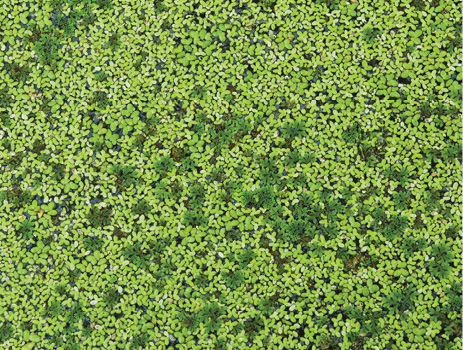Mosquito Fern | Azolla spp.
Floating | Native



Mosquito fern is a tiny native aquatic fern that floats on the water surface. It is most common in sheltered ponds with limited wind exposure. Under optimal conditions, it can completely cover a waterbody and eliminate sunlight penetration.
Individual plants of mosquito fern are generally less than 1 inch wide. The leaves are in two alternating rows along the stem, and are divided into an upper green lobe that floats and a lower white to transparent lobe under the water.
Mosquito fern is green when actively growing and is easily mistaken for duckweed (Lemna spp.) or watermeal (Wolffia spp.) when viewed from a distance. When it is stressed, mosquito fern turns red or brown and is easily distinguishable.
Management Value
Mosquito fern is a native species and has some value as wildlife food and habitat. Fish, amphibians, reptiles, and ducks may eat the plants on occasion, and dense colonies provide habitat for some insect species. However, because mosquito fern can quickly cover a pond and block out sunlight, it is not recommended for any management purpose.
Recommended Controls
Option 1: Flumioxazin (4-pound formulation). For each gallon of water, mix 0.1 ounce flumioxazin and 1.3 ounces nonionic surfactant. Use a buffering agent when mixing with water with pH greater than 7.0. Spray to wet all plants. Do not exceed annual herbicide rate limits as stated on the product label.
Option 2: Diquat (3.73-pound formulation). For each gallon of water, mix 1.28 ounces diquat and 1.3 ounces non-ionic surfactant. Spray to wet all plants. Do not exceed annual herbicide rate limits as stated on the product label.
Multiple herbicide applications may be necessary to eradicate plants.
Read and follow all chemical label instructions, especially the section on the use of personal protection equipment.

The information given here is for educational purposes only. References to commercial products, trade names, or suppliers are made with the understanding that no endorsement is implied and that no discrimination against other products or suppliers is intended.
Publication 3735-43 (POD-11-23)
By Wes Neal, PhD, Extension/Research Professor, Wildlife, Fisheries, and Aquaculture; Dennis Riecke, Fisheries Coordinator, Mississippi Department of Wildlife, Fisheries, and Parks; and Gray Turnage, PhD, Assistant Research/Extension Professor, GeoSystems Research Institute.
The Mississippi State University Extension Service is working to ensure all web content is accessible to all users. If you need assistance accessing any of our content, please email the webteam or call 662-325-2262.



